商务英语阅读Unit 4 International Marketing
- 格式:ppt
- 大小:374.50 KB
- 文档页数:34
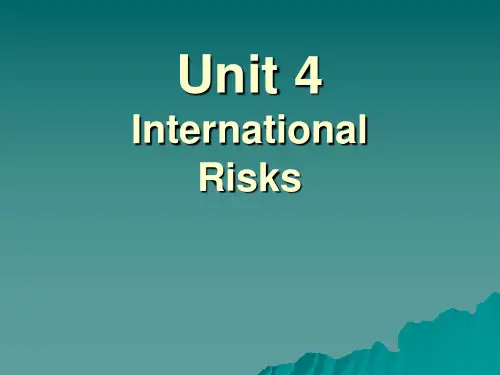

Unit 41. 中东和平谈判正在进行当中。
武汉地铁正在建设当中。
2.客户对我们的服务感到非常满意。
3.对价格敏感的顾客喜欢去买一些减价品,而有品牌意识的顾客则重视产品的声誉。
4行业分析师说,食品零售业市场已达到饱和,企业必须开拓海外市场。
5.中国旅游业有很好的增长前景。
6.由于其较低的利率,这家银行吸收了巨大的顾客存款。
7.对中国地产业的长期盈利性还应打个问号。
8.厂商如果已牺牲产品质量为代价来增加利润的话,就会损害自己的品牌并造成很坏的公众影响。
A technological revolution is under wayA formal negotiation is under way.The subway is under construction.Your proposal is under considerationSelect goods / a select school/ a select group (number) ofBe happy with /aboutTake advantage of cut-price offersBe certain/sure/set to doRetail food market is saturated.Even when the market reaches saturation, the production process doesn’t stop.Prospect of growth / a bright prospect / a dim/ bleak prospectLarge supermarket chains/ chain storeTake over / hand overTake over 20 billion yuan of customer depositsI took over as the editor of the magazineInterest rates on savingsROI = return on investmentThere is a question market over long-term profitability. / feasibilityWiden margins and boost profitsThe effect is marginalMake marginal adjustmentThe new technology will boost the food production.This policy will be a great boost to economy.Boost the morale / confidence of the playersThis film/book has been boosted in Time recently.Create good/bad publicity / hurt the brand / build up a corporate imageDon’t share their fearsOwn-label car / real estate agent /He has no incentive /drive to improve his performance.Offer bonus points with every purchaseThese points add up to free air milesIt really pays to stay loyal to the brand.It pays to keep on the right side of your boss.Competitive edgeDirect / phone sellingThis price is really value for moneyOverheads / running costTurnover / personnel turnover / turnover rate of inventory1. which word is the odd one out?1) trademark brand copyright patent2) innovate stretch diversify extend3) target promote market advertise4) incentive benefit selling-point specification5) customer retailer end-user consumer6) bona fide authentic genuine counterfeit7) discontinue phase out launch recall8) global domestic worldwide international9) shelf-life life expectancy life insurance life cycle10) design name image reputation2. match the nouns then use them to complete the sentences below.Shelf brandLoyalty lifeThird marketOwn partyWindow awarenessMarket schemeRetail advantageCompetitive leaderBlack displayBrand outlet1) We produce fresh pasta so our products only have a short ________.2) We don’t make anything ourselves. We contract out to ______ manufacturers.3) The new ________ encourages customers to buy more of our goods.4) Every year billions of dollars worth of illegal software is sold on the _______.5) The new features will give us a _________ over our nearest rivals.6) Supermarkets sell their __________ products more cheaply than other brands.7) The TV advertisements really helped increase ________ and raise our profile.8) With 62% market share, they are clearly the __________ in this sector.9) With such a boring _________ , it’s no wonder people don’t go into the shop.10) We’re reducin g costs and cutting the number of _______ we sell through.e the following words to complete the email below.Feedback brand loyalty pricing policy premiumLoss-leader household name brand awarenessSamHere’s a quick summary of the market 1_______ on the S220. As expected, a lot of the sales are through existing customers, with 65% of them having upgraded to the S220, so 2_______ seems high. But only 15% of non-current customers had heard of the S220 series so we need to build up 3_________ . I mean 15% doesn’t exactly make the S220 a 4_________ , does it?I think we need to review our 5__________ and think about special promotional discounts and other targeted offers to help grow market share. I know the S220 cost a lot to de velop and I don’t want to turn it into a 7________ but I really think we’re charging too much of a price 8________ to establish a wide enough customer base.Let me know what you think.JulesA niche market /distributor / distribution channelMarketing and Sales●How are you going to promote construct x?●Well, first of all we’ll include it in the new catalogue.●OK. What about advertising?●We’re going to run a campaign in the press, but only in specialist publications. This is a nicheproduct.●Right. Are you going to do a mailing?●Yes, just a flier to our regular customers.●Will you offer them any kind of giveaway?●No, but there will be a discount on orders in the first thirty days●Sounds good.●Well, we’ll see.●Do you think we should focus mainly on the domestic market or go for overseas sales right at thebeginning?●I think domestic to start with. That way we don’t have to worry about distribution problems untillater.●I think I agree. What about pricing?●Well, this is a unique product, there’s no real competition, so it’s going to be fairly high-priced. Don’tyou think so?●Well, that sounds fair. Any thoughts about the package?●Standard ---- a hard case containing the discs and the manual. Technical drawings on the outside togive a precise, professional image.●Are you going to have any point-of-sale displays in computer shops?●Just a poster, using the same image as the packaging.●Well, it all sounds very good.●You’ll find all the details in the report.Point-of-saleSelling pointArouse public awareness of resources conservationReview 11. This ________ here shows exactly how our payment processing works.a) graph b) flow chart c) pie chart2. we had to get a bank _______ to finance the new machinery.a) credit b) finance c) loan3. the market was flooded with cheap _______ products from abroad.a) genuine b) bona fide c) counterfeit4. all our products come with a standard one-year _________.a) warranty b) shelf life c) contract5. the head of department will have to _________ the payment.a) authorise b) summarise c) analyse6. I’m afraid delivery will be late because we have a ________ of ordersa) back date b) batch c) backlog7. we don’t make any profit on it. We’re using it as a ________ to get market share.a) trademark b) loss-leader c) concession8. we’re paying ________ of about 6 % on our finance.a) tax b) penalties c) interest9. we’re moving our headquarters to a new ________ next month.a) leasehold b) location c) construction10. everyone agreed and it was a _________ decision.a) unanimous b) summary c) representative11. I hope the terms of the agreement are to your _________.a) satisfaction b) entertainment c) convenience12. tell the ______ we need to assess the damage before we can pay anything.a) end user b) broker c) claimant13. they’re going to streamline the management _______ to reduce costs.a) administration b) orientation c) structure14. I think the brand’s strong enough to ______ into financial services.a) diversify b) globalise c) innovate15. we’re going to start _______ our com puter systems in autumn.a) renovating b) upgrading c) constructing16. the new product features should give us a competitive ________.a) expectancy b) premium c) advantage17. we improved our ______ channels to get products into shops more quickly.a) distribution b) consignment c) transaction18. we’ll have to be very careful how we ________ suc a small budget.a) supervise b) allocate c) finance19. the company went bankrupt and called in the _____.a) auditors b) accountants c) receivers20. the major TV campaign should help to increase brand _________.a) feedback b) reputation c) awareness21. the contractor put in a _________ for the construction project.a) grant b) statement c) tender22. we put our savings into a high-interest ________ account.a) deposit b) deficit c) debit23. we work very hard at ________ good relationships with our customers.a) launching b) establishing c) negotiating24. we’re hoping to pay off the _______ credit by the end of the year.a) pending b) outstanding c) overdrawn25. supermarkets can maximize profits by selling _________ goods.a) third-party b) black market c) own-brand26. The motorways and new airport have improved the __________.a) capacity b) commuting c) infrastructure27. With a modest budget we had to go for the most ____________ plana) cost-effective b) sophisticated c) state-of-the-art28. They’ve got a good _________ of designing innovative products.a) analysis b) track record c) assessment29. We’re introducing a loyalty _________ with a points card system.a) scheme b) objective c) factor30. With all these new orders, we’re struggling to _________ demand.a) produce b) cater c) satisfy31. The trainee made a lot of mistakes due to a lack of adequate _________.a) brainstorming b) supervision c) control32. We produce locally to avoid the high import ___________.a) tariff b) bonus c) price33. We use a ________ firm to distribute our heavy machinery all over the UK.a) haulage b) courier c) public transport34. With _________ below 2 percent, prices haven’t increased for two years nowa) income tax b) depreciation c) inflation35. They _____ the product due to falling sales after 8 years on the market.a) recalled b) prevented c) discontinued36. You have to fill in two forms to claim back your travel _________.a) overheads b) expenses c) investments37. It all depend s on your _________ of view, doesn’t it?a) point b) type c) angle38. They took out a __________ tot stop other companies copying the design.a) warranty b) patent c) deed39. The__________ investment in the new factory caused financial problems.a) sensible b) suitable c) substantial40. Many _____ dotcom companies go bankrupt within 18 months.a) established b) start-up c) preliminary41. I have to report to my _________ every two weeks.a) chief executive b) company secretary c) line manager42. All 230 ________ stayed in the same hotel where the conference was held.a) members b) delegates c) guests43. My ________ takes care of all my correspondence and my diary.a) partner b) apprentice c) assistant44. Many UK supermarkets have _________ their brands into banking services.a) pushed b) diverted c) stretched45. The brand enjoys very high awareness ---- it’s pretty much a _______ name.a) household b) common c) universal46. Make sure the goods are all in order before you sign the _______ notea) advice b) cover c) delivery47. We have to submit our tax ________ to the tax office by 8 February.a) remittance b) return c) application48. I f sales don’t pick up, we’ll have to review our pricing ______.a) policy b) prediction c) value49. We need to freshen up the window displays at our retail _________.a) offices b) outlets c) facilities。

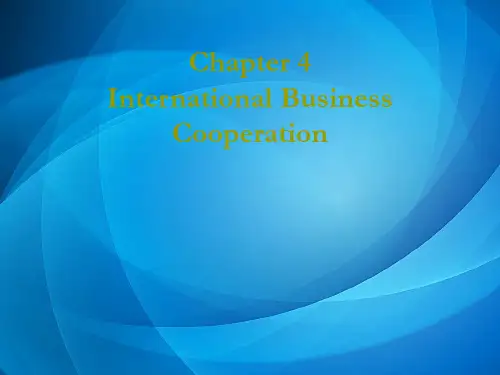
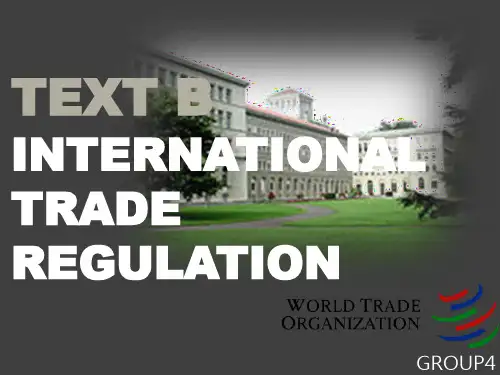

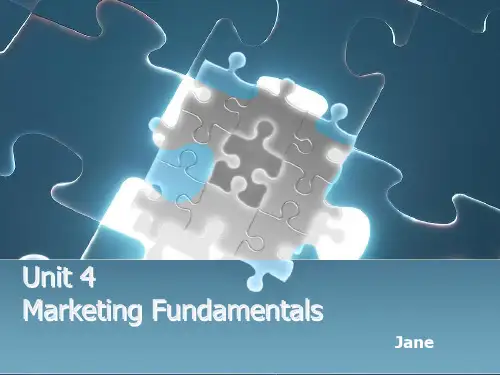
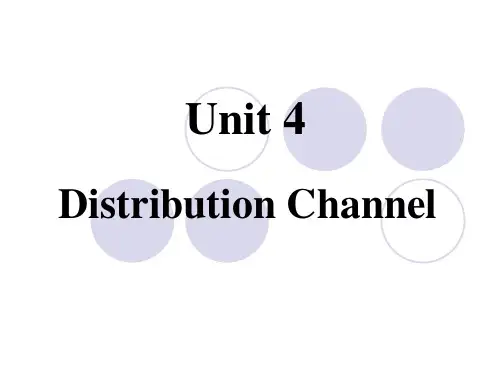
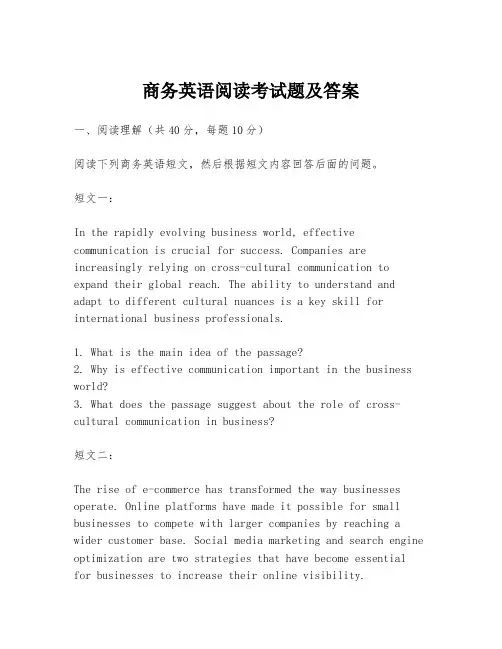
商务英语阅读考试题及答案一、阅读理解(共40分,每题10分)阅读下列商务英语短文,然后根据短文内容回答后面的问题。
短文一:In the rapidly evolving business world, effective communication is crucial for success. Companies are increasingly relying on cross-cultural communication to expand their global reach. The ability to understand and adapt to different cultural nuances is a key skill for international business professionals.1. What is the main idea of the passage?2. Why is effective communication important in the business world?3. What does the passage suggest about the role of cross-cultural communication in business?短文二:The rise of e-commerce has transformed the way businesses operate. Online platforms have made it possible for small businesses to compete with larger companies by reaching a wider customer base. Social media marketing and search engine optimization are two strategies that have become essentialfor businesses to increase their online visibility.1. What is the main topic discussed in this passage?2. How has e-commerce changed the business landscape?3. What are two strategies mentioned in the passage that are important for businesses to increase their online visibility?短文三:Sustainability is becoming a significant factor in business decisions. Companies are recognizing the importance of reducing their environmental footprint and adoptingsustainable practices. This includes the use of renewable energy, waste reduction, and responsible sourcing of materials. Consumers are also becoming more aware and are demanding products that align with their values.1. What is the main focus of the passage?2. Why are companies adopting sustainable practices?3. What are some of the sustainable practices mentioned inthe passage?二、词汇理解(共20分,每题5分)根据短文内容,选择最合适的词汇填空。
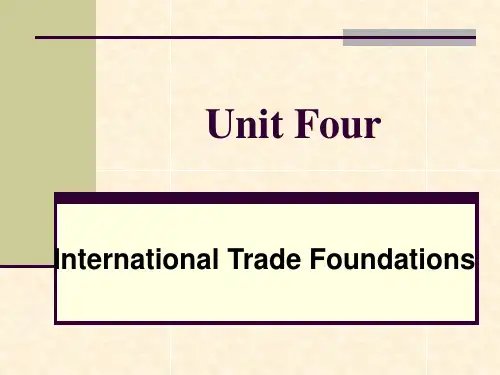

《商务报刊选读》教学大纲一、课程定位1、课程的性质与作用本课程为商务英语专业基础课,一方面要求学生具有扎实的英语语言基本功,熟悉商务英语报刊专业术语及专业词汇,扩大词汇量,能够独立分析商务报刊的文章结构并通过阅读中总结出文章主题。
另一方面要求学生能够进一步提高商务报刊阅读篇章阅读技巧,从而获取经济贸易等领域的时事动态,开阔视野,提高分析问题、解决问题的能力。
2、本课程与其它课程的关系本课程其前导课程为《商务英语精读》、《实用英语语法》、《商务英语阅读》,后续课程为《跨文化商务交际》、《国际人才英语》、《国际贸易法》。
二、课程教学目标通过本课程的学习,学生能够熟知商务报刊的语言特点,掌握商务报刊的语言特色,迅速获得商务篇章的主题思想。
并能够分析商务时事的发展规律,熟悉各种商务文体风格,利用英汉互译方式,加强商务篇章信息获取能力。
三、教学基本要求本课程需要学生具有较强的英语语言理解能力,特别是阅读和问题分析能力。
教师需要了解西方重要报刊的编排、背景、立场及发行量等,了解中国经济和世界经济的发展趋势,能与时俱进。
学生需要重点掌握与国际商务相关的词汇及专业术语,掌握商务报刊的修辞手法,掌握各类报刊的阅读技巧及翻译方法。
四、教学内容及学时分配第一章 Capital Markets (4学时)1、教学内容第一节 Banking Industry第二节 Stock Exchange第三节 American Stock Markets—Reversal of Fortune2、重点、难点重点:Knowing the stock system in banking难点:Understanding the global economic trend第二章 International Marketing (4 学时)1、教学内容第一节 Business Planning—Marketing Planning第二节 Supporting Of Online Campaign Launches with Online Marketing 第三节 Online-coupon Firms—Group on Anxiety2、重点、难点重点:Knowing how to do business planning难点:Understanding online business transaction in international market 第三章 Business Elite (4 学时)1、教学内容第一节 The Resurrection of Steve Jobs第二节 Ann Moore: The CEO of Time第三节 Steve Jobs and the iPad of Hope2、重点、难点重点:Knowing the business entrepreneur难点:Understanding the organizational structure in a company第四章 E-Commerce (4 学时)1、教学内容第一节 In E-Commerce,More Is More第二节 The Alibaba E-Commerce Empire第三节 Online Shopping: Selling Becomes Sociable2、重点、难点重点:Knowing how E-commerce runs in business难点:Understanding online shopping in community第五章Economic Globalization and Multinational Corporation (3学时) 1、教学内容第一节 Globalization VS Economic Sovereignty第二节 The World’s Top Choice第三节McDonald’s Eyes Growing Presence in Local Market2、重点、难点重点:Knowing the globalized economy难点:Understanding multinational corporation growing第六章Economic Regulations and Law (5 学时)1、教学内容第一节 US Sets 21stCentury Goal: Building a Better Patent第二节 Anti-Trust Law Treats“All Firms Equally over 140 Cases Handled 第三节 China E-Commerce Giant Launches Campaign of Fight Online Piracy 2、重点、难点重点:Knowing some business regulations and make some examples难点:Understanding the business law in international market第七章Human Resources Management ( 4学时)1、教学内容第一节 Capturing the State of Human Resources in an Annual Report第二节 The Tech Effect on Human Resources第三节 Risk Management and Human Resources Team up to Cut Absence Costs 2、重点、难点重点:Knowing the effect of human resources management in a company难点:Understanding the assessment of human resources management第八章Advertising and Publicity (44学时)1、教学内容第一节 Internet Advertising第二节 Beijing Tries to Push Beyond “Made in China”第三节 The Harder Hard Sell2、重点、难点重点:Knowing the ways of advertising难点:Understanding the importance of publicity in business第九章 Training (4学时)1、教学内容第一节 Training the Trainer第二节 Training Needs Assessment: A Must for Developing an Effective Training Program第三节An Innovative Method for Role-specific Quality-training Evaluation2、重点、难点重点:Knowing the process of training难点:Understanding the training evaluation of a employee五、课程考核本课程为考查课。
2018年1月05439商务英语阅读Ⅰ. Translate the following words or phrases into Chinese(10%)1. inflation2. turnover3. fringe benefit4. bearer bond5. consignment6. mutual fund7. brokerage8. certificate of origin9. mortgage10. counter offerⅡ. Translate the following words or phrases Into English(10%)11.经济衰退12.股权证13.预付款14.期末存货15.电汇16.赔偿、偿还17.存款18.配额、限额19.仲裁20.风险资本Ⅲ. Choose the best answer to fill in the blanks(10%)21. The most major function of money is __________.A. a store of valueB. the unit of accountC. the medium of exchangeD. a standard of deferred payment22. Which of the following is NOT mentioned in economic loss?A. The destruction of one’s home in a fire.B. Loss of income owing to illness.C. Loss of property owing to theft.D. The destruction of one’s property in an accident.23. An insurance policy is __________.A. a government law on insuranceB. a written contract between the insurer and the insuredC. a piece of paper with the insurer’s signature on itD. a set of rules to regulate the insurance market24. Which of the following can NOT be a feature of a bond?A. It has a certain denomination.B. It has a prefixed interest rate.C. It involves high risk.D. It has a prefixed maturity date.25. __________ is a small structure with one or more open sides that is used to vend merchandise (as newspapers)or services.A. Telephone boothB. KioskC. NewsstandD. Department store26. Marketers can communicate with large numbers of potential customers at the same time by __________.A. personal sellingB. direct sellingC. mass sellingD. sending leaflets27. What is meant by “consideration” in a contract?A. An item of considerable value given to the other party.B. An item of value given to the other party.C. Money in exchange of goods.D. Careful thinking before signing a contract.28. To be a wise customer,we must evaluate __________ and choose to buy what is __________.A. the price;the cheapestB. the product quality;of top qualityC. the total product offer;of the best value to usD. the after-sale service;provided with the best after-sale service29. The following are the elements of marketing mix EXCEPT __________.A. priceB. placeC. point-of-saleD. promotion30. What is the major feature of a global marketing strategy?A. uniformityB. flexibilityC. localizationD. diversityⅣ. In this part,there are some reading passages followed by 15 questions or unfinished statements. For each of them there are four answers marked A,B,C and D. You should decide on the best one according to your understanding(30%)Passage 1Corporate CultureThe term corporate culture refers to an organization’s value system. Managerial philosophies,workplace practices,and organizational network are included in the concept of corporate culture. Tyson Food’s corporate culture is reflected in the fact that everyone-even CEO Don Tyson wears clothes of a yellowish brown color on the job.The leaders who developed the company and the corporate culture typically shape the corporate culture. One generation of employees passes on a corporate culture to newer employees. Sometimes this is part of formal training. New managers who attend McDonald’s Hamburger University may learn skills in management,but they also pick up the basics of the organization’s corporate culture. Employees can absorb corporate culture through informal contacts as well,by talking with other workers and through their experiences on the job.Corporate culture has a major impact on the success of an organization. In organizations with strong cultures,everyone knows and supports the organizations’ objectives. In those with weak cultures,no clear sense of purpose exists. In fact,the authors of the classic book In Search of Excellence concluded the presence of a strong corporate culture was the single common thread among many diverse but highly successful companies such as General Electric and McDonald’s.As you can imagine,changing a company’s corporate culture can be very difficult. But some managers try to do just that when they feel the current culture is weak,or when the organization’s objectives change and the old culture no longer fits. Sometimes the competitive situation of a company changes. For instance,electric utilities,which once had their profits guaranteed by public regulation,now face more competition than ever. Firms that were comfortable competing against other American companies now find themselves fighting competitors from overseas,too.Management expert Peter Duckers feels that,rather than trying to change culture,managers should focus on changing employees and corporate practices,as follows.——Define what results are needed. Specify in measurable terms what the organization or department,or office)needs to achieve.——Determine where these results are already being achieved within the current organization. Analyze the departments that are already effective and find out what they are doing differently from the rest.——Determine what top management can do to encourage these good results. Duckers suggests that executives openly ask what they can do to help,and then do it.——Change the reward system-or develop a new one-to recognize these effective practices. When employees realize that the organization really does reward the new approach,they will adopt it much more quickly. Whether one wants to change an organization culture or not,it is important to choose managers and employees whose personal styles fit the organization’s goals.31. According to the passage,corporate culture __________.A. means the cultural atmosphere in a companyB. is established by top leaders and can’t be changedC. involves the core values of a companyD. has little influence on the performance of a company32. In McDonald’s Hamburger University,new managers __________.A. learn the company’s corporate culture at lengthB. are only interested in learning management skillsC. learn all the necessary skills and practices of the companyD. have chances to know about the company’s corporate culture33. If an organization has a strong corporate culture,__________.A. it can be sure of achieving great successB. it will be as successful as General Electric and McDonald’s pC. its staff tend to work for a common goalD. it may have a strong influence on the market34. One reason why some managers try to change a company’s corporate culture is that __________.A. the existing corporate culture is very strongB. they try to adapt the corporate culture to new situationsC. the company is facing a lot of competitionD. they are not so conservative as the old generation35. Which of the following is NOT advised by Peter Duckers?A. Evaluating different performances of various departments.B. Improving the communication among managers.C. Determine what is to be achieved by the organization.D. Improving the reward system so as to encourage new practices.Passage 2Early Developments in American EconomyEarly American industries depended largely on skilled artisans working in small shops to serve a local market. But the Industrial Revolution that started in England during the 18th century did not take long to cross the Atlantic. It brought many changes to American industry between 1776 and 1860. Because labor was scarce in the United States and wages were high,employers welcomed any new method that could reduce the requirement for labor.One key development was the introduction of the factory system,which gathered many workers together in one workplace and produced goods for distribution over a wide area. The first factory in the United States is generally dated to 1793,when an Englishman named Samuel Slater came to America to build a cotton cloth factory. He built the machinery from memory,because it was a crime to carry factory plant out of England. The success of Slater’s factory started a process of change that turned the northeastern region of the United States into an important manufacturing center. The making of textiles also meant increased demand for cotton,grown in the southern region for the United States. As a result,the nation became a major cotton producer.Another important development was the “American system” of mass production,which originated in the firearms industry about 1800. The new system required precision engineering to create parts that were interchangeable. This,in return,allowed the final product to be assembled in stages,each worker specializing in a specific operation.Just as Slater’s new factory system was being introduced,an American named Eli Whitney made cotton production more efficient by inventing a machine-the cotton gin-that rapidly removed the seeds from the boils of cotton. Removing the seeds by hand was a difficult task;Whitney’s machine made the job almost easy.Whitney also began manufacturing rifles in a new way. Guns had always been made by gun makers working in their homes or small shops. Because the guns were handmade individually,a part from one gun would not necessarily fit another gun. Whitney began making guns with machinery,so that all the parts were the same in each gun. This method of manufacturing goods in a factory,with interchangeable parts,helped to advance American industry.In 1913,the automaker Henry Ford introduced the “moving assembly” line. This was a variation on the earlier practice of continuous assembly. By improving efficiency,it made possible a major saving in labor costs. A new breed of industrial managers began the careful study of factory operations with the aim of finding the most efficient ways of organizing tasks. Theirconcepts of “scientific management” helped to lower the costs of production still further.Lower costs made possible both higher wages for workers and lower prices for consumers. More and more Americans were gaining the ability to purchase products made in the United States.During the first half of the 20th century,mass production of consumer goods such as cars,refrigerators and kitchen ranges helped to revolutionize the ways in which Americans lived.36. In the first paragraph,the author intends to tell us that __________.A. early American industries mainly depended on new methodsB. early American industries mainly depended on people who did skilled work with their handsC. early American industries mainly depended on England industriesD. early American industries mainly depended on new changes37. The first factory in the United States was __________.A. built by an American engineer named Henry FordB. built by an American named Eli WhitneyC. built by an Englishman who built it from memoryD. built by an American who wanted to build a cotton cloth factory38. Another important development was concerning __________.A. the steam enginesB. the mass productionC. the mobile operationD. the textile industry39. Which of the following statements is NOT true?A. Henry Ford influenced American people’s life.B. Henry Ford influenced all manufacturing systems.C. Henry Ford influenced the manufacture of cars.D. Henry Ford influenced the system of business.40. According to the passage,we can draw the conclusions EXCEPT that __________.A. the production efficiency has greatly been improved by the “American System”B. many other machines such as refrigerators,washing machines and vacuum cleaners are produced on the assembly lineC. with the interchangeable parts,American industries advanced greatlyD. the industrial managers began the careful study of the operations with the aim of reducing the methodsPassage 3Problems Potential Exporters Are FacingMany firms fail to succeed,because when they begin exporting they have not researched the target markets or developed an international marketing plum. To be successful,a firm must clearly define its goals,objectives and potential problems. Secondly,it must develop a definitive plan to accomplish its objectives,regardless of the problems involved. Unless the firm is fortunate enough to possess a staff with considerable expertise,it may not be able to take this crucial first step without qualified outside guidance.Often top management is not committed enough to overcome the initial difficulties and financial requirements of exporting. It can often take more time and effort to establish a firm in a foreign market than in the domestic one. Although the early delays and costs involved in exportingmay seem difficult to justify when compared to established domestic trade,the exporter should take a more objective view of this process and carefully monitor international marketing efforts through these early difficulties. If a good foundation is laid for export business,the benefits derived should eventually outweigh the investment.Another problem area is in the selection of the foreign distributor. The complications involved in overseas communications and transportation require international distributors to act with greater independence than their domestic counterparts. Also,since a new exporter’s trademarks and reputation are usually unknown in the foreign market,foreign customers may buy on the strength of the distributing agent’s reputation. A firm should therefore conduct a thorough evaluation of the distributor’s facilities,the personnel handling its account,and the management methods employed.Another common difficulty for the new exporter is the neglect of the export market once the domestic one booms,too many companies only concentrate on exporting when there is a recession. Others may refuse to modify products to meet the regulations or cultural preferences of other countries. Local safety regulations cannot be ignored by exporters. If necessary modifications are not made at the factory,the distributor must make them,usually at a greater cost and probably not as satisfactorily. It should also be noted that the resulting smaller profit margin makes the account less attractive.If exporters expect distributing agents to actively promote their accounts,they must be trained,and their performance continually monitored. This requires a company marketing executive to be located permanently in the distributor’s geographical region. It is therefore advisable for new exporters to concentrate their efforts in a few geographical areas until there is sufficient business to support a company representative. The distributor should also be treated on an equal basis with domestic counterparts. For example,special discount offers,sales incentive program and special credit terms should be available.Considering a joint-venture or licensing agreement is another option for new exporters.However,many companies still dismiss international marketing as unviable. There are a number of reasons for this. There may be import restrictions in the target market,the company may lack sufficient financial resources,or its product line may be too limited. Yet,many products that can compete on a national basis can be successful in the majority of world markets. In general,all that is needed for success is flexibility in using the proper combinations of marketing techniques.41. In the first paragraph,the writer suggests that firms thinking about exporting should __________.A. get professional adviceB. study international marketingC. identify the most profitable marketsD. have different objectives to other exporters42. The writer believes that if sufficient preparation is undertaken __________.A. initial difficulties can be easily avoidedB. the costs can be recovered quite quicklyC. management will become more committedD. the exporter will be successful in the long term43. An exporter should choose a distributor who __________.A. has experienced personnelB. has good communication skillsC. is well-established in the target marketD. is not financially dependent on the import business44. New exporters often make the mistake of ignoring the export market when __________.A. distribution costs are too highB. their product is selling well at homeC. there is a global economic recessionD. distributors cannot make safety modifications45. For a distributor to be successful,the exporter must __________.A. focus on one particular regionB. finance local advertising campaignsC. give the same support as to domestic agentsD. make sure there are sufficient marketing staff locallyV. Read the following passages and finish the exercises of each one(40%)Passage 4Human-resource ManagementIf sustainable competitive advantage depends on work-force skills,American firms have a problem. Human-resource management is not traditionally seen as central to the competitive survival of the firm in United States. Skill acquisition is considered an individual responsibility. Labor is simply another factor of production to be hired-rented at the lowest possible cost-much as one buys raw materials or equipment.The lack of importance attached to human-resource management can be seen in the corporate hierarchy. In an American firm the chief financial officer is almost always second in command. The post of head of human-resource management is usually a specialized job,off at the edge of the corporate hierarchy. The executive who holds it is never consulted on major strategic decisions and has no chance to move up to Chief Executive Officer(CEO). By way of contrast,in Japan the head of human-resource management is central-usually the second most important executive,after the CEO,in the firm’s hierarchy.While American firms often talk about the vast amounts spent on training their work forces,in fact they invest less in the skills of their employees than do either Japanese or German firms. The money they do invest is also more highly concentrated on professional and managerial employees. And the limited investments that are made in training workers are also much more narrowly focused on the specific skills necessary to do the next job rather than on the basic background skills that make it possible to absorb new technologies.As a result,problems emerge when new breakthrough technologies arrive. If American workers,for example,take much longer to learn how to operate new flexible manufacturing stations than workers in Germany(as they do),the effective cost of those stations is lower in Germany than it is in the United States. More time is required before equipment is up and running at capacity,and the need for extensive retraining generates costs and creates bottlenecks that limit the speed with which new equipment can be employed. The result is lower pace of technological change. And in the end the skills of the population affect the wages of the top half. If the bottom half can’t effectively staff the processes that have to be operated,the management and professional jobs that go with these processes will disappear.A. Mark the following statements true(T)or false(F)according to the passage(10%)46. The management of human resources in American companies sees the gaining of skills as their employees’ own business.47. The head of human-resource management in an American firm is directly under the chief financial executives in the firms.48. The money most American firms put in training mainly goes to workers who lack basic background skills.49. According to the passages,the decisive factor in maintaining a firm’s competitive advantage is the rational composition of professional and managerial employees.50. According to the passage,the human-resource management strategies of American firms affect their competitive capacity.Passage 5Introduction to CompaniesThe General Nature of Companies(56)A company is a form of business organization which is owned by all those who invest in it. These investors are known as shareholders as they own or “hold” a share of the company.The size of their share of the company will depend upon the amount of money they have invested in it.The total investment by all of the shareholders is known as the share capital of the company. Thus,unlike a sole trader,where one person owns the business,or a partnership,where a small number of people own a business,a company may be owned by several hundred or even several thousand shareholders.Obviously,all of these people cannot be involved in running the company. Instead,the shareholders appoint directors to run the company on their behalf,if the directors run the company efficiently and make a profit,the shareholders will receive a dividend each year as a return on their investment.Characteristics of CompaniesThe characteristics of companies differ in several respects from both sole traders and partnerships. The following are among the more important differences.Separate Legal Entity(57)A unique feature of a company is that,no matter how many individuals have bought shares in it,it is treated in its dealings with the outside world as if it was a person in its own right. It is said to be a separate legal entity. Just as the law can create this separate legal person,so also can it eliminate it,but its existence can only be terminated by using the proper legal procedures.Thus,the identity of the shareholders in a large concern may be changing daily as shares are bought and sold by different people. On the other hand,a small private company may have the same shareholders from the date it is incorporated(the day it legally came into being),until the date when liquidation is completed(the cessation of the company,often known also as “winding up” or being “wound up”). A prime example of its identity as a separate legal entity is that it may sue its own shareholders,or in turn be sued by them.Limited LiabilityMost companies are “limited” companies. This means that any shareholder who has paid forthe share(s)which he has bought cannot be forced to pay more money into the company if,for example,it is making losses or has gone into liquidation.(58)Thus,the maximum amount of money any shareholder can lose by investing in a company is the amount he has invested. Unlike in sole traders or partnerships a shareholder in a limited company cannot be forced to sell his house,car,etc. to pay the debts of the business.If a shareholder has not paid in full for the shares he has agreed to buy,he can be forced to pay the balance owing on the shares. Once he has paid that amount he cannot be forced to pay any further amount. Thus,his liability is limited to the amount he has agreed to pay but has not yet paid.This is known as limited liability and the company is known as a limited company. It is important to note that it is the liability of the shareholders that is limited not the liability of the company.(59)Companies can incur debts well beyond what they are able to pay and therefore their liabilities can exceed their assets.There are,as will be seen later,some companies,known as unlimited companies,in which the liability of the shareholders is not limited. Limited liability and the ability to raise large amounts of finance are the principal reasons why limited companies are the most common form of business organization.Public Companies and Private CompaniesBroadly speaking,there are two classes of company,the public company and the private company. Public companies are also known as PLCs,that is,public limited companies.A private company may not have less than two,or more than fifty,shareholders(excluding employees and ex-employees)and may not offer its shares to the general public. Once some someone has purchased shares in a private company the right to transfer those shares to someone else is severely restricted.A PLC is a company which fulfils the following conditions:. It must be able to issue share capital of at least 30,000;. It must have at least seven shareholders. There is no maximum;. Its name must end with the words “public limited company” the abbreviation “plc”.A private company is usually,but not always,smaller than a public company.The shares that are dealt in on the Stock Exchange are all of public limited companies.This does not mean that all public companies’ shares are traded on the Stock Exchange,as,for various reasons,some public companies have either chosen not to,or not been allowed to,have their share traded there. The ones that are traded in are known as quoted companies or listed companies meaning that the price of shares in them is quoted(or listed)by the Stock Exchange. Quoted companies have to comply with Stock Exchange rules and regulations.Share Capital and DividendsA shareholder in a limited company obtains his reward for investing in the form of a share of the profits,known as a dividend.(60)The directors decide how much of the profits is to be retained in the company and used for expansion. Out of the profits remaining they propose the payment of a certain amount of dividend. The shareholders cannot propose a dividend for themselves higher than that already proposed by the directors. They can,however,propose that a lesser dividend should be paid,although this action is very rare. If the directors propose that no dividend be paid,then the shareholders are powerless to alter the decision.The decision by the directors as to the amount proposed as dividends is a very complex one.Such matters as the effect of taxation,the availability of bank balances to pay the dividends,the possibility of take-over bids and so on will all be taken into account.Dividends are usually expressed as a percentage of the share capital. A dividend of 10% in Company A on 500,000 Common Shares of £ 1 each will amount to £ 50,000,or a dividend of 6% in Company B on 200,000 Common Shares of £ 2 each will amount to £ 24,000. A shareholder having 100 shares in each firm would receive £ 10 from Company A and £ 12 from Company B.B. Choose the best answer for the following questions(10%)51. A most significant difference between a public company and a small private company lies in that __________.A. a public company has more shareholders than a private companyB. the shareholders of a public company can secure a dividend each year whereas the shareholders of a private company does notC. the identity of the shareholders of a public company may be changing daily whereas the identity of the shareholders of a private company almost remains the sameD. a public company is treated as a separate legal entity whereas a private company is not52. Which of the following statements is true?A. Unlike a sole trader or partnership a shareholder in an unlimited company can forced to sell his house or car to pay the debts of the business.B. Like a sole trader or partnership a shareholder in a limited company also faces the risk of being forced to sell his house or car to pay the debts of the business.C. The liabilities of a limited company cannot exceed its assets.D. The liability of a shareholder of a limited company is limited to what he has invested in it.53. Which of the following statements is NOT true?A. The number of a private company’s shareholders may not exceed fifty.B. A PLC must have at least seven shareholders.C. A PLC is always larger than a private company.D. Listed companies are those whose shares are traded on Stock Exchange.54. The shareholders of a PLC have the right to do all of the following EXCEPT __________.A. attend general meetings of the companyB. vote for directors at a general meeting of the companyC. propose a dividend for themselves higher than that already proposed by the boardD. propose a dividend less than that already proposed by the board55. When the directors decide the amount proposed as dividends,they have to take into consideration all the following EXCEPT __________.A. the effect of taxationB. whether they have enough money on the account to pay the dividendsC. the number of the company’s shareholdersD. whether they have enough reserves possibly to be used to take over some other company through Stock ExchangeC. Translate the underlined sentences into Chinese(56)(57)(58)(59)(60)(10%)。